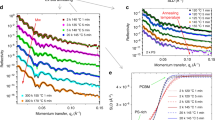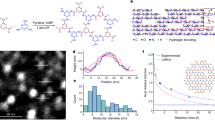Abstract
The use of polymer thin films in technology is increasingly widespread—for example, as protective or lithographic surface coatings, or as active (electronic or optical) elements in device architectures. But it is difficult to generate films of polymer mixtures with homogeneous surface properties, because of the tendency of the polymers to phase-separate1,2. Copolymer compatibilizers can induce miscibility in polymer blends, but only with chemical components that are either close to a critical point in the phase diagram3 or which have an attractive interaction between them4,5. Instead of manipulating the chemical composition of the blend, we show here that complete mixing can be obtained in polymer blends by the physical effect of confinement in thin films. The compatibilization results from entropic inhibition of phase separation into micelles, owing to confinement. The result is an intimately mixed microemulsion with a perfectly flat surface and a two-dimensional maze-like structure with columnar domains that extend through the film.
This is a preview of subscription content, access via your institution
Access options
Subscribe to this journal
Receive 51 print issues and online access
$199.00 per year
only $3.90 per issue
Buy this article
- Purchase on Springer Link
- Instant access to full article PDF
Prices may be subject to local taxes which are calculated during checkout




Similar content being viewed by others
References
Karim, A. et al . Phase-separation induced surface patterns in thin polymer blend films. Macromolecules 31, 857–862 (1998).
Dalnoki-Veress, K., Forrest, J. A., Stevens, J. R. & Dutcher, J. R. Phase separation morphology of spin-coated polymer blend thin films. Physica A 239, 87–94 (1997).
Bates, F. S. et al . Polymeric bicontinuous microemulsions. Phys. Rev. Lett. 79, 849–852 (1997).
Shull, K. R., Kellock, A. J., Deline, V. R. & Macdonald, S. A. Vanishing interfacial-tension in an immiscible polymer blend. J. Chem. Phys. 97, 2095–2104 (1992).
Xu, Z., Jandt, K. D., Kramer, E. J., Edgecombe, B. D. & Frechet, J. M. J. Direct observation of a diblock copolymer-induced microemulsion at a polymer/polymer interface. J. Polym. Sci. B 33, 2351–2357 (1995).
Shull, K. R. Interfacial phase-transitions in block copolymer homopolymer blends. Macromolecules 26, 2346–2360 (1993).
Shull, K. R., Kramer, E. J., Hadziiannou, G. & Tang, W. Segregation of block copolymers to interfaces between immiscible homopolymers. Macromolecules 23, 4780–4787 (1990).
Hu, W. C., Koberstein, J. T., Lingelser, J. P. & Gallot, Y. Interfacial-tension reduction in polystyrene/poly(dimethylsiloxane) blends by the addition of poly(styrene-b-dimethylsiloxane). Macromolecules 28, 5209–5214 (1995).
Russell, T. P. et al . Width of homopolymer interfaces in the presence of symmetrical diblock copolymers. Macromolecules 24, 5721–5726 (1991).
Green, P. F. & Russell, T. P. Segregation of low-molecular-weight symmetrical diblock copolymers at the interface of high-molecular-weight homopolymers. Macromolecules 24, 2931–2935 (1991).
Fleer, G., Cohen-Stuart, M. A., Scheutjens, J. M. H. M., Cosgrove, T. & Vincent, B. Polymers at Interfaces (Chapman & Hall, London, (1993).
Lyatskaya, Y., Gersappe, D., Gross, N. A. & Balazs, A. C. Designing compatibilizers to reduce interfacial tension in polymer blends. J. Phys. Chem. 100, 1449–1458 (1996).
Semenov, A. N. Theory of diblock-copolymer segregation to the interface and free-surface of a homopolymer layer. Macromolecules 25, 4967–4977 (1992).
Qu, S. Dewetting Dynamics at Polymer Interfaces. Thesis, State University of New York at Stony Brook(1998).
Ade, H. et al . Bulk and surface characterization of a dewetting thin film polymer bilayer. Appl. Phys. Lett. 73, 3775–3777 (1998).
Acknowledgements
NEXAFS microscopy was performed with the Stony Brook STXM at the National Synchrotron Light Source, developed by the groups of J. Kirz and C. Jacobsen with support from the Office of Biological and Environmental Research, and the NSF. We thank S. Spector and C. Jacobsen for developing the zone plates, with support from the NSF. The NSLS is supported by the Office of Basic Energy Sciences, Energy Research, Department of Energy. This work was supported by the NSF DMR-MRSEC Program and by a NSF Young Investigator award.
Author information
Authors and Affiliations
Corresponding author
Rights and permissions
About this article
Cite this article
Zhu, S., Liu, Y., Rafailovich, M. et al. Confinement-induced miscibility in polymer blends. Nature 400, 49–51 (1999). https://doi.org/10.1038/21854
Received:
Accepted:
Issue Date:
DOI: https://doi.org/10.1038/21854
This article is cited by
-
Polystyrene-based blend nanorods with gradient composition distribution
Science China Chemistry (2012)
Comments
By submitting a comment you agree to abide by our Terms and Community Guidelines. If you find something abusive or that does not comply with our terms or guidelines please flag it as inappropriate.



